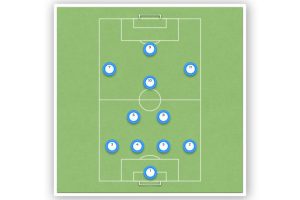The Evolution Of The Attacking Midfielder Position In Soccer
The attacking midfielder position in soccer has come a long way since its inception. It’s often called the most important role on the field, requiring players to be both creative and disciplined. Today, it’s evolved into one of the most demanding positions in modern football, but how did we get here?
In this article, we’ll explore the evolution of the attacking midfielder position and examine some of the key changes that have shaped the game over time.
Attacking midfielders are responsible for linking defense with attack by providing support to their team’s forwards while also helping out defensively when needed. This requires great tactical awareness, as well as an ability to read the game quickly and accurately interpret situations.
With so much responsibility resting on their shoulders, it’s no wonder why they’ve become such a critical part of any successful side. Let’s take a look at how they’ve developed over time!
Origins Of The Attacking Midfielder Position
The attacking midfielder position has played a crucial role in the evolution of soccer. It is considered one of the most important positions on the field and requires players with an array of tactical flexibility and attributes that are difficult to find.
These player traits include strong intelligence, technical ability, creativity, speed, vision, physicality and knowledge of different formations.
As tactics have developed over time, so too has the importance placed upon this pivotal position. Attacking midfielders have become increasingly influential as teams attempt to break down stubborn defences by unlocking their opponents’ shape via intricate passing combinations or direct runs beyond defenders.
Their ability to transition between attack and defence quickly while maintaining possession enables them to control games from deep areas; something which was impossible in decades gone-by due to more rigid systems being employed by coaches.
With modern day football becoming evermore dynamic and unpredictable, it’s clear why the attacking midfielder plays such a vital role for teams competing at all levels. The challenge now lies in finding those special players who possess both raw talent and studied understanding of positional play – qualities which will no doubt be sought after for many years to come.
Moving into the next section then, we look at how these developments have resulted in contemporary changes within the game itself.
Evolution Of Tactics Over Time
The attacking midfielder position has come a long way since its inception. Its development was driven by tactical evolution and changing team dynamics, which allowed teams to create unique formations and maximize their players’ abilities.
First and foremost, the tactical development of soccer saw an increase in offensive play with greater emphasis on ball possession and passing accuracy. This meant that midfielders had to be more creative when going forward while still maintaining defensive duties. It also brought about the need for personnel who could link up defense with attack quickly, thus creating space for attackers to exploit.
As such, the attacking midfielder was born: they were given license to roam between lines of pressure and pick out passes or drive at opposition defenses.
Attacking midfielders have become increasingly important with regards to team dynamics too; they not only help maintain control of the game but offer an extra man in attack as well as provide cover in cases of transition. Additionally, some attacking midfielders are used as false 9s – strikers deployed slightly deeper than usual – allowing them to drop into pockets of space between defenders instead of leading the line alone.
The result is often increased creativity from deep areas of the pitch, enabling sides to create chances from unexpected angles and zones.
Evolution Of Player Roles
The attacking midfielder position in soccer is like a conductor orchestrating an entire symphony. Changing dynamics and interactive play are the notes that come together to create beautiful music on the pitch. These players have evolved over time from defensive-minded workhorses, whose only job was to protect their backlines, into creative outlets for offense with technical skills, speed, and tactical awareness.
Today’s game requires more than just physicality; instead it calls upon attacking midfielders who can think quickly and make intelligent decisions under pressure. They must possess excellent vision and passing ability—all while performing at top speed—to open up space for themselves or teammates while creating goal-scoring opportunities.
In this way they’re vital cogs turning within the machine of any successful team. With these requirements in mind, let us now explore modern day attacking midfielders and their unique abilities.
Modern Day Attacking Midfielders
Modern Day Attacking Midfielders have adapted their roles to the current tactical landscape of soccer. They have developed a wide range of skills and techniques, with an emphasis on technical ability and tactical awareness.
Attacking midfielders are now responsible for both defensive and offensive duties, requiring them to be well-rounded players capable of finding solutions in tight spaces. This has brought about innovations such as ‘tiki-taka’ football, where intricate passing combinations between teammates can create goal scoring opportunities through quick interchanges.
Attacking midfielders also possess superior decision making abilities when it comes to knowing when to press forward or drop back depending on the game situation. Their role requires them to retain possession while simultaneously providing support to other attacking players by supplying incisive passes or clever runs off the ball into space.
With modern formations becoming increasingly flexible, attacking midfielders must take up different positions during build ups yet remain focused on linking up defense and attack efficiently.
The Future Of Attacking Midfielders
The future of attacking midfielders is an exciting prospect as the position continues to evolve. Although some may argue that it has reached its peak, with cultural influence and tactical innovations still at play in the modern game, there remains potential for further development – both on a global scale and more locally within teams.
Attacking midfielders are often required to possess certain technical attributes such as speed, dribbling ability, creativity and vision; however they also need specific skills which can be tailored to suit different approaches and systems used by coaches around the world.
The combination of these abilities have enabled attackers to become more adept at linking up with other players while creating chances for themselves or their teammates – something which many view as essential in helping teams achieve success.
With this in mind, it’s clear that attacking midfielders will continue to develop in line with current trends and techniques, making them ever-more important figures on the pitch.
Frequently Asked Questions
What Are The Physical And Technical Requirements For An Attacking Midfielder?
The attacking midfielder position requires a player with a unique set of physical and technical skills.
They must be able to share the role with other players, as well as protect the ball while creating scoring opportunities for their team.
The attacking midfielder needs to possess excellent dribbling and passing abilities, good off-ball running coordination, a strong sense of positioning in order to create space for teammates, plus an eye for goal.
Additionally, they need to have great vision, agility and quick decisions on the pitch when trying to break through defences.
How Does The Attacking Midfielder Position Compare To Other Positions On The Field?
The attacking midfielder position is one of the most important on a soccer pitch. Their tactical awareness, passing accuracy and ability to link up with other players makes them key for creating goal scoring opportunities.
Compared to other positions, an attacking midfielder has more freedom in their role as they are not restricted by defensive duties that come with playing in midfield or at the back.
They are also required to have great vision and be able to find space quickly when determined opposition defenders can close down spaces quickly.
What Types Of Skills Do The Best Attacking Midfielders Possess?
Attacking midfielders possess a unique set of skills that can make or break their team’s performance.
From creative passing to tactical awareness, the best attacking midfielders have an uncanny ability to lead teams in both offensive and defensive play.
Armed with superior vision and game intelligence, they are capable of breaking down opposing defenses through clever movement and intricate passes.
Additionally, these players must be able to read opponents’ strategies quickly to facilitate successful counterattacks and provide valuable support for defenders when needed.
Thus, it is no wonder why this position can be so crucial for any soccer team looking for success on the field.
What Are The Key Differences Between Attacking Midfielders In Different Countries?
Attacking midfielders in different countries can vary greatly, from the player selection process to their tactical awareness.
For instance, some nations may prefer a more powerful attacking midfielder who is adept at bursting forward and shooting on goal, while others might focus on playmakers with great vision and technical ability.
Ultimately, each nation will have its own distinct style of selecting players for this role as well as its own playing philosophy that dictates how they are expected to perform during matches.
What Kind Of Career Path Do Attacking Midfielders Typically Take?
Attacking midfielders have a unique career path that requires tactical awareness and mental agility in order to reach the highest level of play.
Players typically start off at a local club, where they can hone their skills, before progressing through the ranks to join an elite team.
From there, it’s all about refining their technique and understanding how the game is played from different perspectives in order to elevate themselves above their peers.
With hard work and dedication, attacking midfielders can make a successful career out of playing soccer professionally.
Conclusion
The attacking midfielder position in soccer is a unique and important role. These players need to be well-rounded, physically strong, technically sound and tactically astute. They must possess the ability to read the game, create chances for their team and score goals themselves.
As it has been said: ‘Knowledge is power’ – this certainly applies to successful attacking midfielders who use their knowledge of the game to gain an advantage over opponents.
The career path for attacking midfielders varies from country to country but one thing remains consistent; those that reach the top have worked hard on every aspect of their game and continue to strive for excellence.






